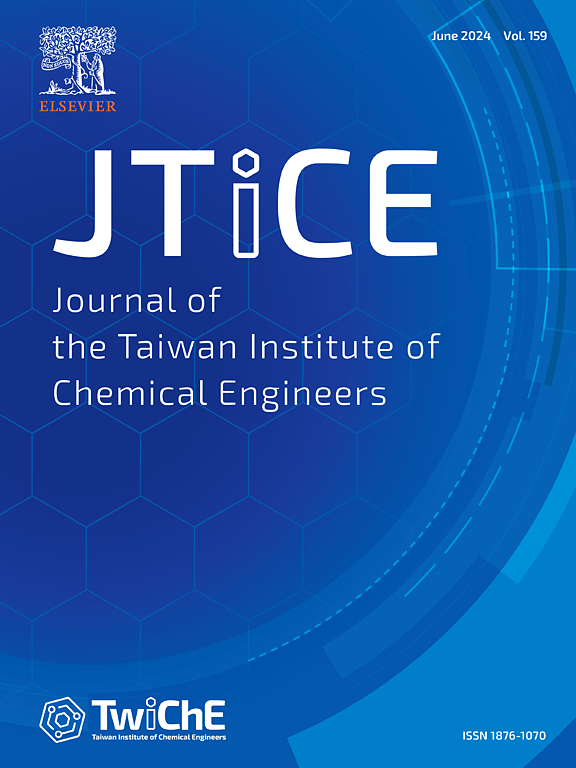Investigation of the pore structure and surface properties of polysulfone membrane on the resultant polyamide layer and the performance of the reverse osmosis membrane
IF 5.5
3区 工程技术
Q1 ENGINEERING, CHEMICAL
Journal of the Taiwan Institute of Chemical Engineers
Pub Date : 2025-04-19
DOI:10.1016/j.jtice.2025.106147
引用次数: 0
Abstract
Background
Polyamide (PA) thin-film composite reverse osmosis (RO) membranes are mainly composed of nonwoven fabric layer, polysulfone (PSF) ultrafiltration support layer, and polyamide separation layer. The structure of PSF membrane plays a decisive role for the properties and morphology of the PA layer. However, the properties and structural parameters of PSF membranes suitable for fabricating high-performance RO membrane are ambiguous, and the relationship between the structure of PSF membrane and the property of PA layer are still unclear.
Methods
Here, PSF membranes with different cross-sectional structures, pore-size distributions, surface porosity, and hydrophilicity were prepared by introducing PEG with different molecular weight and concentration, which altered the viscosity of the casting solution and the solvent/nonsolvent exchange rate. Based on these PSF membranes, RO membranes were fabricated to investigate the impact of PSF membrane on the structure of PA layer.
Significant findings
PSF membrane with larger pore-size (> 100 nm) and hydrophobic surface resulted to defects of the PA layer due to the uneven dispersion of the MPD-containing aqueous solution, while PSF membrane with relative high porosity (3–5 %) and hydrophilic surface lead to irregular PA layer originated from excessive penetration of aqueous solution to the PSF membrane. Thus, PSF membranes suitable for the formation of uniform and dense PA thin-layer should have a relatively dense cross-sectional structure, smaller pore-size (40–60 nm) and lower surface porosity (<3 %).

研究了聚酰胺层上聚砜膜的孔结构和表面特性以及反渗透膜的性能
聚酰胺(PA)薄膜复合反渗透(RO)膜主要由非织造布层、聚砜(PSF)超滤支撑层和聚酰胺分离层组成。聚砜膜的结构对聚砜层的性能和形态起着决定性的作用。然而,适合制作高性能反渗透膜的PSF膜的性能和结构参数尚不明确,PSF膜的结构与PA层性能之间的关系尚不清楚。方法通过引入不同分子量和浓度的聚乙二醇,制备了具有不同横截面结构、孔径分布、表面孔隙率和亲水性的聚砜膜,改变了铸膜溶液的粘度和溶剂/非溶剂交换率。在此基础上制备了反渗透膜,研究了PSF膜对PA层结构的影响。spsf膜孔径较大(>;100 nm)和疏水表面由于含有mpd的水溶液分散不均匀导致PA层的缺陷,而具有相对高孔隙率(3 - 5%)的PSF膜和亲水性表面由于水溶液对PSF膜的过度渗透导致PA层不规则。因此,适合形成均匀致密的PA薄层的PSF膜应具有相对致密的横截面结构、较小的孔径(40-60 nm)和较低的表面孔隙率(< 3%)。
本文章由计算机程序翻译,如有差异,请以英文原文为准。
求助全文
约1分钟内获得全文
求助全文
来源期刊
CiteScore
9.10
自引率
14.00%
发文量
362
审稿时长
35 days
期刊介绍:
Journal of the Taiwan Institute of Chemical Engineers (formerly known as Journal of the Chinese Institute of Chemical Engineers) publishes original works, from fundamental principles to practical applications, in the broad field of chemical engineering with special focus on three aspects: Chemical and Biomolecular Science and Technology, Energy and Environmental Science and Technology, and Materials Science and Technology. Authors should choose for their manuscript an appropriate aspect section and a few related classifications when submitting to the journal online.

 求助内容:
求助内容: 应助结果提醒方式:
应助结果提醒方式:


